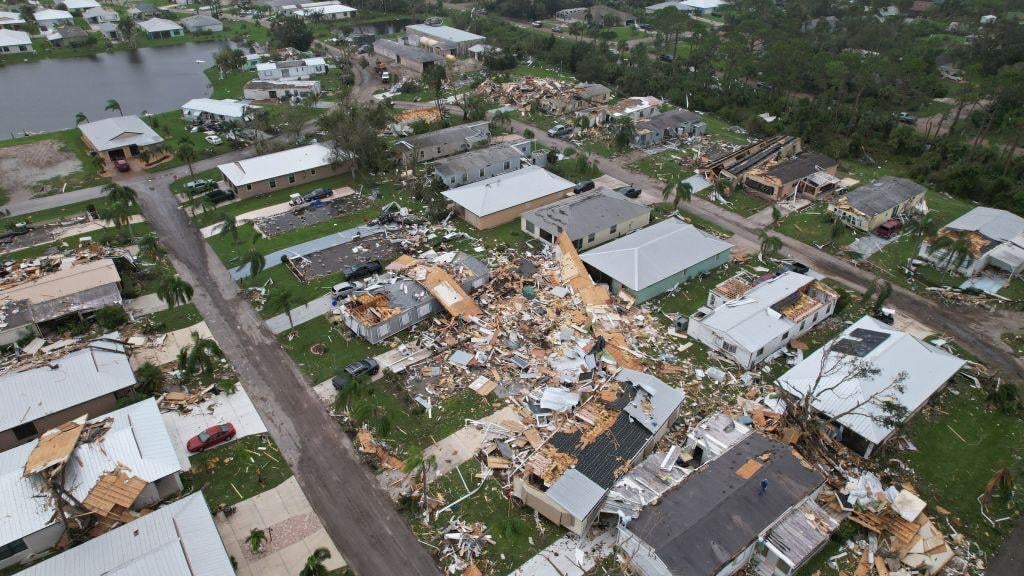
News Service of Florida — About $2.126 billion in estimated insured losses had been reported as of Wednesday from Hurricane Milton, which made landfall Oct. 9 in Sarasota County and caused widespread damage in the state. Numbers of claims and estimated insured losses have steadily increased since the storm.
By the numbers, via the Florida Office of Insurance Regulation:
172,658: Total number of claims.
141,062: Claims for damage to residential property.
23,243: Claims for damage to “private passenger” vehicles.
3,973: Claims for damage to commercial property.
4,737: Number of claims closed with payments to policyholders.
6,579: Number of claims closed without payments to policyholders.
Damages to farmers and ranchers from Hurricane Milton may double the statewide agricultural destruction from three other storms that pummeled Florida since August 2023, according to state Department of Agriculture and Consumer Services Commissioner Wilton Simpson.
Simpson estimated Milton caused between $1.5 billion and $2.5 billion, on top of more than $1.5 billion in damages already sustained from hurricanes Idalia, Debby and Helene.
Simpson included the assessment in a letter Thursday asking U.S. Department of Agriculture Secretary Tom Vilsack to make assistance available to Florida farmers through the Farm Service Agency and other federal programs.
“With four major hurricanes in just over a year, our agriculture communities have been hit repeatedly, causing unprecedented financial strain,” Simpson said in a release. “We need the USDA’s immediate support to help these family farms recover from yet another historic storm. The time to act is now.”
Preliminary estimates from Simpson’s agency found Milton impacted 51 counties as it swept ashore Oct. 9 near Siesta Key in Sarasota County with 120 mph sustained winds.
“This major hurricane follows several years of above average rainfall, severe storms and winds, other tropical cyclones, hard freezes, and the significant economic disruption to all sectors of the economy caused by supply chain issues and mounting inflationary pressures, which may hinder access to necessary resources these farmers need,” Simpson wrote in Thursday’s letter to Vilsack.
The state agency’s report found major structural impacts to nurseries and cattle ranches, while power outages caused disruptions to cow-milking operations. Cotton, peanut and rice crops suffered “minor to catastrophic” damages. Vegetables, melons, blueberries, strawberries, and tropical fruits experienced “significant damages,” according to the report.
The citrus industry, already in the midst of a historically low production season before Milton’s arrival, is facing fruit drop and concerns of flooded fields from Milton that will result in tree mortality, the preliminary report said.
Preliminary findings by the University of Florida Institute of Food and Agricultural Sciences, known as UF/IFAS, estimate that Debby, which hit Florida Aug. 5 with 80 mph sustained winds, caused $93.7 million to $263.2 million in agricultural losses. Debby affected more than 2.2 million acres of agricultural land in the state, with two-thirds of the land used for livestock grazing.
By comparison, Idalia, which made landfall in August 2023 with maximum sustained winds of 115 mph, affected 3.5 million acres and caused production losses of $276 million. Beef cattle, dairy cattle, poultry, and aquaculture accounted for $157.6 million in estimated losses from Idalia.
The university-based institute has not yet released preliminary findings for Helene, which made landfall Sept. 26 with 140 mph winds, and recently began collecting data from farmers and ranchers to assess damage from Milton.
Milton slugged many areas that were still recovering from Hurricane Ian, a Category 4 storm in September 2022. Ian caused crop production and infrastructure losses of $1.18 billion to $1.89 billion.
This post was originally published on this site be sure to check out more of their content.


